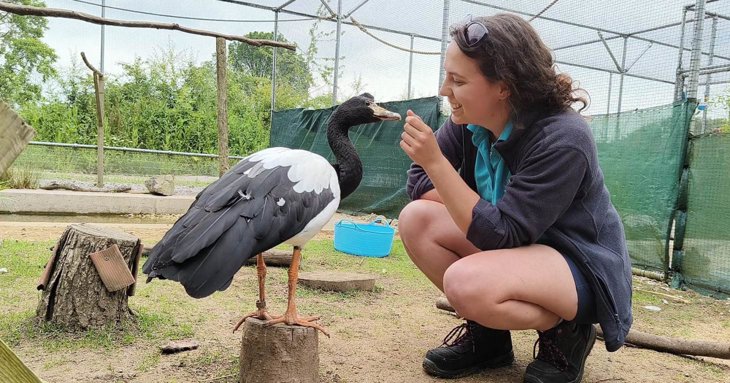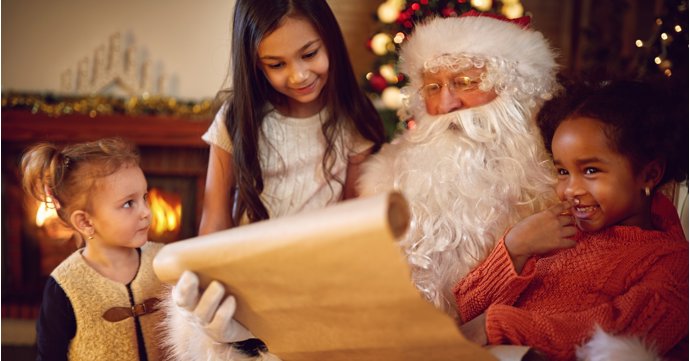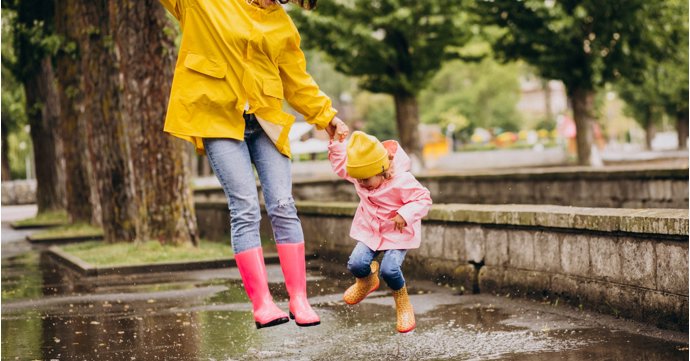At WWT Slimbridge Wetland Centre, the demonstrations team has one mission: to educate and inspire.
Through expert training and live displays and talks, Slimbridge brings wetland wildlife closer while supporting conservation and welfare. SoGlos caught up with Nikki Stakesby-Lewis, living collections supervisor, to find out what it takes to be part of the demonstrations team.

Can you describe the type of training you do at WWT Slimbridge?
We train many of our animals across different sections, including the birds in our Living Wetland Theatre displays.
When training the birds, animal welfare is at the forefront of our minds. We utilise positive reinforcement, which means the birds are offered treats, toys or attention – whichever is their favourite – when they do a behaviour we want to see and they get ignored for the things we don’t.
The strong relationships we invest in are incredibly important for successful training and allow us to bring birds outside their aviaries without worrying they’ll just fly off; we’re safe and positive to be around, so they’re happy to hang out with us.
Most importantly, our training is about giving our animals choice and control – we’d all much rather do something we choose to do and our birds are the same.
What does a typical training session look like?
Before a training session, trainers read notes from previous sessions and refresh themselves on the plan, so they’re up to date on what has or hasn’t worked well and what direction to go in next.
We set up the environment to help the animal get the most success; this could mean removing an obstacle from a bird’s flightpath or distracting a companion so they don’t accidentally sabotage the session. We gather reinforcement items – treats or toys – and get ready to start.
We begin with fun, easy behaviours the bird knows well, such as calling over, standing on a station, or sitting on a perch. This lets us gauge their interest, preferred foods and mood.
Once we have good attention, we move into the behaviour they are learning. As they master each stage, we gradually make it more complex. We constantly watch for subtle signs they aren’t engaged anymore and try to end on a good, fun behaviour, leaving them with extra tasty treats or enrichment to finish the session.
What are the benefits of the training – is it purely for audience enjoyment?
The training we do isn’t just for public displays; it must have a positive impact on the animals’ welfare too.
Behind the scenes, we train birds to help us care for them in ways that minimise stress for both them and us. For example, entering travel crates voluntarily so we don’t have to catch them, which is especially helpful for unexpected transport or vet visits; standing on weighing scales so we can easily monitor health; or getting used to being touched so medications can be administered easily and regularly without restraint.
Other behaviours encourage natural actions like hunting, foraging or prolonged flight, which also benefits their health and fitness.
Every training session is designed to keep the birds mentally stimulated and enriched, supporting welfare and keeping them excited and engaged.
Why are demonstrations so central to WWT Slimbridge's conservation work?
The reason we exist is to educate and inspire!
As a conservation charity, it is incredibly important to us to preserve the natural world for generations to come. Our work is multifaceted but requires the public to engage with the problems we are trying to solve.
The best way to do that is through education and providing access to the natural world to as many people as possible, in as many ways as possible.
Our displays give us a captive audience for educational talks, which are more effective than signage or interpretation and are known to boost engagement, learning and conservation awareness.
We talk about the evolutionary adaptations of each species, the habitats they come from, and conservation issues affecting them – building emotional engagement with them and similar species, which contributes to people taking action to support our work.
For some visitors, seeing Sprout, our pink-backed pelican, or Nzuri the crane, fly over their heads draws them in, but once here they are exposed to so much more and leave with a deeper appreciation for nature than they arrived with.
How do you measure the impact of the displays on visitor awareness and behaviour?
We hear visitors say they are returning to Slimbridge specifically to see one of the birds in our display, stories of kids pestering their parents to see Sprout again or even performing their own pelican talks at home after visiting.
There’s also evidence in young people inspired to enter the field of conservation, or families who become WWT members.
We see firsthand that our talks inspire a love for nature and wetlands, creating more opportunities for visitors to connect with our work.
What skills do you and the team need in order to deliver these kinds of displays successfully?
Multitasking is essential for a presenter in front of a large audience, especially on stage with a live animal who doesn’t know – or care – about the carefully structured script.
As animal trainers, we are also behaviour analysts. Our birds can’t speak English and we don’t speak goose, so we have to read subtle behavioural shifts to understand what the animal is thinking.
We also need patience, empathy and curiosity. The saying 'never work with children or animals' holds true in our line of work; it would be easy to call a bird ‘stubborn’ and get frustrated when it doesn’t do what we expect.
Instead, we slow down, imagine ourselves as the bird and get curious about what might be affecting them. Is it a strange noise? Something blocking their flightpath? Strong wind? We then problem-solve with the bird to help them succeed, which makes for a great display!
Are there any new behaviours or display elements you're currently working towards?
Frequent visitors will notice our displays change slightly with the seasons and as our birds learn more skills, they are able to show off even more behaviours.
Currently, two of our magpie geese, Livvy and Lucy, are building fitness for longer sustained flights, as well as learning a fun new dabbling behaviour that shows audiences how they forage below the water’s surface.
We have also recently received a brand-new species, which we are excited to train behind the scenes, hopefully ready for their stage debut in the not-too-distant future!
Do you have a favourite species you love working with the most?
The answer I should give here, is that I love all the birds I work with equally… but the truth is that I could talk about Magpie Geese all day!
They’re an Australian bird which are actually neither a magpie nor a goose and they are such an ancient species they are considered living fossils – so basically dinosaurs!
They are absolutely full of character and each have unique personalities which make them challenging but incredibly interesting to work with.





















